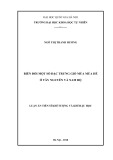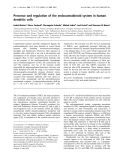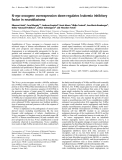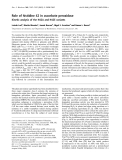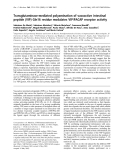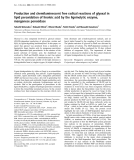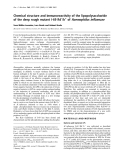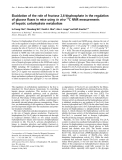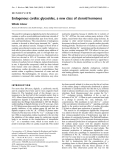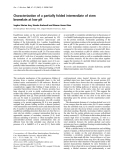
Structural and compositional changes in very low density lipoprotein
triacylglycerols during basal lipolysis
Jyrki J. A
˚gren
1,2
, Amir Ravandi
1
, Arnis Kuksis
1
and George Steiner
3
1
Banting and Best Department of Medical Research, University of Toronto, Ontario, Canada;
2
Department of Physiology,
University of Kuopio, Finland;
3
Department of Medicine and Physiology, The Toronto Hospital (General Division),
Toronto, Ontario, Canada
Triacylglycerols secreted by liver and carried by very low
density lipoprotein (VLDL) are hydrolysed in circulation by
lipoprotein and hepatic lipases. These enzymes have been
shown to have positional and fatty acid specificity in vitro.If
there were specificity in basal lipolysis in vivo, triacylglycerol
compositions of circulating and newly secreted VLDL would
be different. To study this we compared the composition of
normal fasting VLDL triacylglycerol of Wistar rats to that
obtained after blocking lipolysis by Triton WR1339, which
increased plasma VLDL triacylglycerol concentration about
4.7-fold in 2 h. Analyses of molecular species of sn-1,2- and
sn-2,3-diacylglycerol moieties and stereospecific triacylglyc-
erol analysis revealed major differences between the groups in
the VLDL triacylglycerol composition. In nontreated rats,
the proportion of 16:0 was higher and that of 18:2n-6 lower in
the sn-1 position. The proportion of 14:0 was lower in all
positions and that of 18:0 was lower in the sn-1 and sn-3
positions in nontreated rats whereas the proportions of
20:4n-6, 20:5n-3, 22:5n-3 and 22:6n-3 were higher in the sn-1
and lower in the sn-2 position. These results suggest that the
fatty acid of the sn-1 position is the most decisive factor in
determining the sensitivity for hydrolysis of the triacylglyc-
erol. In addition, triacylglycerol species with highly unsat-
urated fatty acids in the sn-2 position also favoured
hydrolysis. The in vivo substrate specificity followed only
partly that obtained in in vitro studies indicating that the
nature of molecular association of fatty acids in natural
triacylglycerol affects its susceptibility to lipolysis. To con-
clude, our results indicate that preferential basal lipolysis
leads to major structural differences between circulating and
newly secreted VLDL triacylglycerol. These differences
extend beyond those anticipated from analysis of total fatty
acids and constitute a previously unrecognized feature of
VLDL triacylglycerol metabolism.
Keywords: diacylglycerols; enantiomers; hydrolysis; stereo-
specific analysis; reverse isomers.
1Very low density lipoprotein (VLDL) secreted from liver is
the major carrier of triacylglycerols in the fasting state and
its assembly, secretion and hydrolysis have been extensively
studied [1–3]. It has been generally assumed that the
triacylglycerol composition of circulating VLDL resembles
that of the VLDL newly secreted by the liver, although very
few studies have examined the effects of basal lipolysis on
circulating VLDL.
VLDL triacylglycerols are hydrolysed by lipoprotein and
hepatic lipases [4]. These enzymes have been shown to have
positional and fatty acid specificity in vitro [5,6]. However,
most studies concerning substrate specificity have been
performed with human or bovine milk lipoprotein lipase
using chylomicrons or synthetic triacylglycerols, including
alkyl ethers, as substrates [5–8]. The properties of human
and bovine milk lipoprotein lipase may differ [9] as may the
properties of milk and endothelial lipoprotein lipase [10].
Because the biosynthesis of intestinal chylomicron and
hepatic triacylglycerols proceed along different routes [11],
structurally dissimilar triacylglycerols would have been
subject to endogenous lipolysis during clearance of post-
prandial chylomicron triacylglycerols and of VLDL triacyl-
glycerols further complicating the interpretation of earlier
results.
Previous studies [12–14] have shown that Triton WR1339
(a nonionic detergent) blocks lipolysis by inhibition of
lipoprotein and hepatic lipases, which leads to accumulation
of VLDL triacylglycerols. In one study [15], the fatty acid
composition of serum lipids was shown to differ between
control serum and serum collected 6 h after Triton injection.
However, only the major fatty acids were measured in
serum total triacylglycerols, while the fatty acids of liver
triacylglycerols were not determined. As Triton WR1339
has been shown to disturb lysosomal lipolysis in liver [16], it
is possible that prolonged treatment had affected the fatty
acid composition directed by the liver to the VLDL
assembly. Short-term injections of Triton WR1339 have
given no indication of ill effects [17–19].
The present study was carried out to confirm in vivo the
nonrandomness of the basal lipolysis demonstrated in vitro
and to establish the extent to which the newly secreted
VLDL triacylglycerol is modified during circulation. We
limited treatment with Triton WR1339 to 2 h, which did not
induce changes in the fatty acid composition of liver
triacylglycerol. The results showed significant differences in
the VLDL triacylglycerol composition between control and
Triton-treated animals.
Correspondence to J. A
˚gren, Department of Physiology,
University of Kuopio, P.O.B. 1627, FIN70211 Kuopio, Finland.
Fax: +358 17 163112, Tel.: +358 17 163091,
E-mail: Jyrki.Agren@uku.fi
Abbreviations: VLDL, very low density lipoprotein; NEU, naphthyl
ethyl urethane.
(Received 18 September 2002, accepted 31 October 2002)
Eur. J. Biochem. 269, 6223–6232 (2002) FEBS 2002 doi:10.1046/j.1432-1033.2002.03341.x

MATERIALS AND METHODS
Animal procedures
2
Male Wistar rats weighing 300–350 g and maintained on
standard chow and 12-h light/dark cycle (07.00, 19.00 hours)
were used (n¼10). In the experimental day food was
removed at 08.00 hours and rats were anesthetized with
Somnatol (50 mgÆkg
)1
) at 12.00 hours. A cannula was
inserted into femoral veinand Triton WR1339 (600 mgÆkg
)1
)
or saline was injected (12.30–13.00 hours). Two hours
after injection blood was drawn and rats were killed by
heart puncture. The blood samples were taken into 5%
EDTA and plasma was immediately separated by centrifu-
gation. Plasma was overlaid with a NaCl solution
(d¼1.006 gÆmL
)1
) and VLDL was separated by ultracen-
trifugation at 37 000 r.p.m. in a 70.1 Ti rotor (Beckman) for
16 h at 16 C. Livers were removed and stored at )70 C. All
experiments were performed under protocols approved by
the Animal Care Committee and the University of Toronto.
Separation of triacylglycerols
Lipids from VLDL and liver samples were extracted with
chloroform/methanol (2:1, v/v) [20]. Triacylglycerols were
separated by TLC on silica gel H plates using heptane/
isopropyl ether/acetic acid (60 : 40 : 4, v/v/v) as the devel-
oping solvent. The triacylglycerol band was scraped off,
extracted in chloroform/methanol (2 : 1) and stored in
chloroform at )20 C.
Analysis of fatty acid methyl esters
Triacylglycerols were subjected to acidic methanolysis using
6% H
2
SO
4
in methanol at 80 C for 2 h. The fatty acid
methyl esters were extracted with hexane and analysed by
capillary gas chromatograph (HP 5880, Hewlett-Packard)
using a 15-m SP-2380 column (0.25 mm i.d., 0.20 lmfilm
thickness).
Plasma VLDL neutral lipid profile
Neutral lipids were separated from total lipid extract using a
silica Sep-Pak column (Waters) [21] and their profile was
determined with capillary GC [22]. Samples were silylated
with pyridine/trimethylchlorosilane (1 : 1) and extracted
with hexane before injection into 8 M HP-5 column
(Hewlett-Packard; 0.30 mm i.d., 0.25 lm film thickness).
The oven temperature was programmed from 40 to 150 C
at 30 CÆmin
)1
and to 340 Cat10CÆmin
)1
.
Preparation of diacylglycerols and their naphthyl ethyl
urethane (NEU) derivatives
Plasma VLDL and liver triacylglycerols were partially
deacylated to sn-1,2, sn-2,3 and sn-1,3 diacylglycerols by
Grignard reaction and products were immediately deriva-
tized [23,24]. Diacylglycerols were dissolved in dry toluene
(0.3 mL) and (R)-(–)-1-(1-naphthyl)ethyl isocyanate (10 lL)
and 4-pyrrolidinopyrridine (4 mg) were added. The mixture
was heated at 50 C overnight. After evaporation of
solvents with nitrogen stream the reaction products were
dissolved in methanol/water (95 : 5) and applied to Sep-Pak
C18 column (Waters), which had been solvated with the
same solvent. Further 15 mL of this solvent was passed
through the column and NEU derivatives were then eluted
with acetone (10 mL).
HPLC/ESI/MS of diacylglycerols
The sn-1,2 and sn-2,3-diacylglycerols were separated [24]
and analysed as diastereomeric NEU derivatives with a
Waters 550 HPLC connected through a Waters 990
photodiode array detector to a Hewlett-Packard 5989A
quadrupole mass spectrometer equipped with a nebulizer-
assisted electrospray interface. Two normal phase silica gel
columns (Supelcosil LC-Si, 5 lm, 25 cm ·4.6 mm i.d.,
Supelco Inc., Bellefonte, PA, USA) in series were used and
0.37% isopropanol in hexane was used as a mobile phase at
a flow rate of 0.7 mLÆmin
)1
. Positive chemical ionization
was obtained by postcolumn addition of chloroform/
methanol/30% ammonium hydroxide (75 : 24.5 : 0.5, v/v)
at 0.6 mLÆmin
)1
. The capillary exit voltage was 220 V and
the mass range scanned was m/z 500–720. The relative
proportions of diacylglycerol species were calculated from
the areas of the single ion plots obtained from the mass
spectra. NEU derivatives of VLDL diacylglycerols were
collected after HPLC separation. A sufficient amount of
sample for fatty acid analyses was obtained from three
Triton-treated and two nontreated rats.
Almost complete separation of sn-1,2 and sn-2,3-diacyl-
glycerol was obtained as their R-forms of NEU derivatives.
However, a part of 38 and 40 acyl carbon sn-1,2-diacyl-
glycerol eluted concurrently with sn-2,3-diacylglycerol. For
example, 16:1–22:6 sn-1,2-diacylglycerol was separated into
two peaks (indicating a separation on the basis fatty acid
location in diacylglycerol), and the first one eluted with the
sn-2,3-diacylglycerol fraction. There was, however, overlap
with the corresponding sn-2,3-diacylglycerol species only in
few cases and these values were corrected using the results
from the runs of (S)-form NEU derivatives. Also sn-1,3
diacylglycerols were separated but they were not used for
calculations because this fraction has been reported to be
readily contaminated by isomerization [25].
Stereospecific analysis and calculations
The stereospecific positional distribution of the fatty acids
was determined by calculation from the fatty acid compo-
sition of total triacylglycerols and the sn-1,2- and sn-2,3-
diacylglycerols recovered from a HPLC separation as
described by Yang and Kuksis [26]. The molecular associ-
ation of the fatty acids and reverse isomer content of the
triacylglycerol and the derived sn-1,2- and sn-2,3-diacyl-
glycerols were determined by calculation on the basis of the
knowledge of the fatty acid composition of the sn-1, sn-2
and sn-3 positions of the acylglycerols, assuming 1-random,
2-random and 3-random distribution [27]. The molecular
associations give the exact pairs of fatty acids in individual
diacylglycerol and the exact triplets of fatty acids in
individual triacylglycerol.
Statistics
The values have been expressed as mean ± SD. The
Mann–Whitney U-test was used for comparisons of groups.
6224 J. J. A
˚gren et al. (Eur. J. Biochem. 269)FEBS 2002

RESULTS
Effect of Triton WR1339 on plasma and VLDL triacyl-
glycerol levels
Plasma and VLDL triacylglycerol concentrations were
4.8 ± 0.8 and 4.4 ± 0.9 mmolÆL
)1
in Triton-treated and
1.4 ± 0.2 and 0.9 ± 0.2 mmolÆL
)1
in nontreated rats,
respectively. This shows that blocking lipolysis by Triton
WR1339 increased plasma and VLDL triacylglycerol levels
about 3.5 and 4.7 times in 2 h, respectively. On the
presumption that the VLDL triacylglycerol concentration
in Triton-treated rats was the same as in nontreated rats
before injection it could be estimated that VLDL contained
at least 80% unmodified triacylglycerol in the Triton-treated
group. This percentage could be also somewhat higher if
there has been any removal of VLDL particles during the
treatment. The very small amount of VLDL diacylglycerol
(0.2 ± 0.0% of neutral lipids) in Triton-treated rats indi-
cate also a minor contribution of modified VLDL. Prelimi-
nary studies showed linear increase of plasma triacylglycerol
concentration at least for 4 h after Triton injection.
However, 4-h treatment was found to affect the fatty
acid composition of liver triacylglycerols, and a similar
tendency was observed in overnight fasted rats with 2-h
Triton treatment. To avoid this effect on liver triacylgly-
cerols, and possibly on secreted triacylglycerol composition,
a shorter food deprivation period was used in the present
study. The increase of VLDL triacylglycerol concentration
was identical to that seen in overnight fasted rats and also
the neutral lipid profiles of VLDL fractions were similar
indicating that chylomicrons did not contribute to the
VLDL fraction.
Neutral lipid profile of VLDL
There were statistically significant differences in the neutral
lipid profile between Triton-treated and nontreated rats
(Table 1). The relative amounts of free cholesterol, choles-
terol esters and diacylglycerols were greater and those of
total triacylglycerols were smaller in nontreated rats. In
addition, the proportions of 50 and 54 acyl carbon
triacylglycerols were lower and those of 56 and 58 acyl
carbon triacylglycerols were higher in nontreated compared
with Triton-treated rats.
Fatty acid composition of VLDL and liver
The proportions of saturated fatty acids in the total VLDL
triacylglycerols were lower in nontreated rats, with the
exception of slightly higher proportion of 16:0 (Table 2).
The levels of 18:1n-9, 18:2n-6 and 20:4n-6 were similar in
both groups whereas the proportions of 16:1n-7, 18:1n-7
and 18:3n-3 were lower, and those of 20:3n-6, 20:5n-3,
22:5n-3 and 22:6n-3 were higher in nontreated rats. There
were no significant differences in the liver triacylglycerol
fatty acid composition between the groups although two
rats in the Triton-treated group with lower proportions of
polyunsaturated fatty acids caused some differences in the
mean values. These rats did not differ, however, from the
other Triton-treated rats in their VLDL fatty acid compo-
sition.
Molecular species of
sn
-1,2 and
sn
-2,3-diacylglycerols
There were statistically significant differences between the
groups in about half of the measured sn-1,2- and sn-2,3-
diacylglycerol species (Table 3). In nontreated rats there was
less 16:0–16:1 and 16:1–16:1 in both sn-1,2- and sn-2,3-
diacylglycerols and less 18:0–18:1 and 18:1–18:2 in the
sn-1,2-diacylglycerols and 16:0–18:2 and 16:1–18:2 in the
sn-2,3-diacylglycerols whereas the proportion of 16:0–18:1
was higher in the sn-1,2-diacylglycerols. In addition, the
proportions of 16:0–20:4 and 16:0–20:5 were lower and
those of diacylglycerol species with a combination of
18- and 22-acyl carbon fatty acids were higher in both
sn-1,2- and sn-2,3-diacylglycerols in nontreated rats. A small
amount of 20:5–22:6 was also found in the sn-2,3-diacyl-
glycerols and its level was higher in nontreated rats.
There were not significant differences in the sn-1,2 and
sn-2,3-diacylglycerol composition of liver triacylglycerols
between the groups. Compared with VLDL the proportions
of 16:0–16:0, 16:0–18:0 and 16:0–18:1 were higher and those
of 16:0–18:2, 16:0–20:4 and 16:0–20:5 were lower in the liver
sn-1,2-diacylglycerol (Fig. 1A). In the sn-2,3-diacylglycerols
the proportions of 16:0–18:0, 16:0–18:1 and 18:0–18:1 were
higher and those of 16:0–20:4 and most species containing
22:6n-3 were lower in the liver than in the VLDL
triacylglycerols (Fig. 1B).
Positional distribution of VLDL triacylglycerol
fatty acids
Positional analyses of VLDL triacylglycerol fatty acids
showed that the lower proportions of most saturated fatty
acids (14:0, 15:0, 17:0 and 18:0) in nontreated rats were
mainly caused by their lower proportions in the positions
sn-1 and sn-3 (Table 4). In contrast, the proportion of major
saturated fatty acid, 16:0, was higher in the sn-1 position in
nontreated rats. The proportions of major 20- and 22-acyl
carbon fatty acids were higher in the sn-1 position and lower
in the sn-2 position in nontreated rats.
Table 1. Composition of plasma VLDL neutral lipids in Triton-treated
and nontreated rats. Neutral Lipids were separated from total lipid
extracts by solid phase extraction and analysed by GLC. Results are
expressed as mass percentages and are mean ± SD for each group of
five rats.
Triton-treated Nontreated
Cholesterol 4.5 ± 0.4 4.0 ± 0.3
Cholesterol esters 2.2 ± 0.4 3.6 ± 0.5
c
C16 0.6 ± 0.1 1.0 ± 0.1
b
C18 1.6 ± 0.2 2.6 ± 0.3
c
Diacylglycerols 0.2 ± 0.0 1.2 ± 0.4
c
Triacylglycerols 93.1 ± 0.5 91.1 ± 0.7
c
C48 (+ C49) 3.2 ± 0.8 2.9 ± 0.5
C50 (+ C51) 13.2 ± 1.3 11.0 ± 0.6
b
C52 33.8 ± 1.3 33.5 ± 1.2
C54 20.6 ± 0.7 18.4 ± 0.7
c
C56 17.2 ± 0.9 19.2 ± 0.9
b
C58 5.1 ± 0.5 6.1 ± 0.5
c
Statistical comparison between the groups:
a
P< 0.05;
b
P< 0.02;
c
P< 0.01.
FEBS 2002 Modification of VLDL triacylglycerols by lipolysis (Eur. J. Biochem. 269) 6225

The proportions of some major VLDL triacylglycerol
species and their reverse isomers, calculated on the basis of
stereospecific positional distribution of fatty acids, are
presented in Table 5. In nontreated rats, the proportions of
most triacylglycerol species with 50 or fewer acyl carbons or
containing 18:0 were lower. Otherwise the fatty acid in the
sn-1 position seemed to have greatest influence on hydro-
lysis. The proportions of triacylglycerol species with 18:2
were mostly lower, and those with 16:0 were higher in
nontreated rats whereas there were not much difference in
the species with 18:1 in the sn-1 position. In addition, the
proportions of triacylglycerol species with 20:4, 20:5, 22:5 or
22:6 in the sn-1 position were higher in nontreated rats.
DISCUSSION
Effect of Triton WR1339 on lipoprotein metabolism
The effect of Triton WR1339 on VLDL secretion rates has
been extensively investigated [17] and the developed meth-
odology applied in recent studies [18,19] assessing the effects
of genetic manipulation of the secretion of apoB-48 and
apoB-100 containing VLDL. In the present study we
investigated the effect of basal lipolysis on plasma VLDL
triacylglycerols by comparing the composition of VLDL
triacylglycerols under normal physiological conditions to
that obtained after Triton WR1339 treatment. In addition
to blocking triacylglycerol lipolysis by inhibition of lipo-
protein and hepatic lipases [12,14], Triton WR1339 has also
other effects on plasma and liver lipid metabolism. It has
been reported to incorporate preferentially into the high
density lipoprotein particles displacing especially apolipo-
protein A-I [28]. Apolipoprotein B or lipids were not
displaced from low density lipoprotein (LDL) particles
indicating that neither should there be marked association
of Triton to newly secreted VLDL particles containing
mainly apolipoprotein B. Triton accumulates also in liver
lysosomes disturbing the lysosomal hydrolysis of VLDL
[16]. This may change the fatty acid composition of secreted
VLDL due to possible depletion of cellular triacylglycerol
stores and increased use of phospholipids as a source of
triacylglycerol fatty acids [29] during prolonged Triton
treatment. To minimize these effects we used only a 2 h
treatment and were able to obtain VLDL fraction with 4.7
times greater triacylglycerols concentration than in non-
treated rats. Although the possibility of unknown side-
effects of Triton treatment cannot be ruled out, none of the
known effects of Triton WR1339 gives reason to suppose
that it had affected the composition of accumulated VLDL
triacylglycerols in circulation. Furthermore, similar fatty
acid compositions of liver triacylglycerols and phospholi-
pids (data not shown) in both groups indicate that the
composition of secreted VLDL triacylglycerols was not
affected by Triton WR1339 during the treatment.
The effect of lipolysis on plasma VLDL neutral lipids in
nontreated rats was evident from a reduced triacylglycerol
and increased diacylglycerol proportion. The higher pro-
portion of cholesterol esters in nontreated rats could also
result from the removal of triacylglycerols. However, the
proportion of free cholesterol was not higher in nontreated
rats indicating that the ratio cholesterol ester : cholesterol in
VLDL is modified in the circulation and that Triton
treatment affects these events also. It was shown earlier that
lecithin cholestrol acyltransferase activity is decreased as
Triton WR1339 displaces apolipoprotein A-I in the high
density lipoprotein particles [28] but its other possible effects
on cholesterol metabolism or transfer are unknown. The
greater proportion of 54 and 56 acyl carbon triacylglycerols,
Table 2. Fatty acid composition of VLDL and liver triacylglycerols. Fatty acid methyl esters were prepared from VLDL and liver triacylglycerols by
acidic methanolysis and analysed by GLC. Results are expressed as mole percentages and are mean ± SD for five rats per group.
Triton-treated
VLDL Liver
Triton-treated Nontreated Triton-treated Nontreated
14:0 1.5 ± 0.3 1.0 ± 0.1
c
1.4 ± 0.2 1.3 ± 0.2
15:0 0.8 ± 0.1 0.6 ± 0.1
c
0.8 ± 0.2 0.7 ± 0.1
16:0 27.0 ± 0.4 27.8 ± 0.4
a
31.2 ± 2.8 29.5 ± 1.7
17:0 0.5 ± 0.1 0.4 ± 0.0
c
0.6 ± 0.1 0.5 ± 0.1
18:0 3.5 ± 0.7 2.5 ± 0.3
a
3.3 ± 0.6 3.6 ± 0.7
16:1n-9 0.6 ± 0.1 0.5 ± 0.1 0.7 ± 0.1 0.7 ± 0.2
16:1n-7 2.8 ± 0.3 2.0 ± 0.5
a
2.8 ± 0.8 1.8 ± 0.6
18:1n-9 24.8 ± 1.0 24.9 ± 0.7 26.1 ± 1.6 23.9 ± 1.5
18:1n-7 3.7 ± 0.1 3.2 ± 0.3
c
4.7 ± 0.4 3.7 ± 0.8
20:1n-9 + 11 0.4 ± 0.1 0.4 ± 0.1 0.4 ± 0.1 0.3 ± 0.1
18:2n-6 21.6 ± 1.0 21.8 ± 1.3 17.6 ± 1.7 20.5 ± 2.1
18:3n-3 1.3 ± 0.1 1.0 ± 0.1
c
0.8 ± 0.1 0.9 ± 0.2
20:2n-6 0.3 ± 0.1 0.4 ± 0.0 0.4 ± 0.1 0.4 ± 0.0
20:3n-6 0.4 ± 0.1 0.7 ± 0.2
a
0.4 ± 0.1 0.5 ± 0.1
20:4n-6 1.7 ± 0.1 1.7 ± 0.2 1.6 ± 0.2 2.0 ± 0.4
20:5n-3 1.5 ± 0.1 1.7 ± 0.1
a
0.8 ± 0.2 1.2 ± 0.4
22:4n-6 0.4 ± 0.1 0.5 ± 0.2 0.4 ± 0.1 0.5 ± 0.1
22:5n-3 1.8 ± 0.2 2.2 ± 0.3
a
1.6 ± 0.5 2.2 ± 0.6
22:6n-3 5.3 ± 0.4 6.7 ± 1.1
b
4.3 ± 1.5 5.6 ± 0.8
Statistical comparison between the groups:
a
P< 0.05;
b
P< 0.02;
c
P< 0.01.
6226 J. J. A
˚gren et al. (Eur. J. Biochem. 269)FEBS 2002

containing most of the 20- and 22-carbon fatty acids in
plasma VLDL [30] of nontreated rats corresponds with the
differences observed in the fatty acid and enantiomeric
diacylglycerol composition.
Specificity of endogenous lipases
Lipoprotein and hepatic lipases hydrolyse VLDL triacyl-
glycerols and they have been shown to have positional
specificity for the sn-1 ester of triacylglycerol [5,31,32]. Using
purified human milk lipoprotein lipase and a synthetic
triacylglycerol mixture [5], the relative order of fatty acid
release was 18:1 > 18:3 > 18:2 > 14:0 > 16 > 0 > 18:0.
The observation of preferential hydrolysis of 18:2n-6 over
16:0 in the sn-1 position as well as the lower proportions of
14:0 and 18:3n-3 in the VLDL triacylglycerol of nontreated
rats are in accordance with these results. On the other hand,
the proportion of 18:0, which would have been expected to
be most resistant to hydrolysis, was lower in nontreated rats.
Furthermore, no preference for 18:1n-9 was seen in the
present study. This discrepancy could be due to the fact that
in the in vitro studies monoacid triacylglycerols were used,
e.g. tristearoyl- and trioleoylglycerol, whereas natural
triacylglycerols would have a more varied fatty acid
distribution. The results obtained indicate that the accessi-
bility of triacylglycerol to lipase is determined by both the
nature of the fatty acid and its position and association with
other fatty acids in the triacylglycerol molecule.
In keeping with the above discussion, greater differences
were found between the treated and nontreated groups of
Table 3. The proportions of sn-1,2 and sn-2,3 diacylglycerols from plasma VLDL triacylglycerols. NEU derivatives of diacylglycerols were prepared
after partial deacylation of plasma VLDL triacylglycerols and they were separated and analysed by HPLC/MS as described in Methods. Results are
expressed as mean ± SD for five rats per group.
C:DB Diacylglycerol species
sn-1,2 sn-2,3
Triton-treated Nontreated Triton-treated Nontreated
30:0 14:0–16:0 0.8 ± 0.3 0.4 ± 0.2
a
0.3 ± 0.1 0.3 ± 0.1
30:1 14:0–16:1 0.6 ± 0.2 0.4 ± 0.1 0.3 ± 0.1 0.2 ± 0.1
32:0 16:0–16:0 4.8 ± 0.9 4.6 ± 0.3 2.5 ± 0.5 2.1 ± 0.4
32:1 16:0–16:1 4.9 ± 0.5 3.6 ± 0.2
c
2.5 ± 0.3 2.0 ± 0.3
a
32:2 16:1–16:1 2.3 ± 0.3 1.3 ± 0.1
c
1.1 ± 0.2 0.7 ± 0.1
b
33:0 16:0–17:0 + 15:0–18:0 0.6 ± 0.2 0.6 ± 0.1 0.3 ± 0.1 0.3 ± 0.1
33:1 16:1–17:0 + 15:0–18:1 1.4 ± 0.2 1.1 ± 0.1
a
0.6 ± 0.1 0.5 ± 0.1
34:0 16:0–18:0 2.2 ± 0.2 2.2 ± 0.7 1.6 ± 0.1 1.3 ± 0.2
34:1 16:0–18:1 + 16:1–18:0 19.3 ± 0.9 22.3 ± 0.8
c
7.0 ± 0.4 6.5 ± 0.5
34:2 16:0–18:2 + 16:1–18:1 21.7 ± 1.1 22.4 ± 0.5 9.4 ± 0.5 7.9 ± 0.5
c
34:3 16:1–18:2 + 16:0–18:3 6.5 ± 0.8 7.0 ± 0.9 4.5 ± 0.4 3.6 ± 0.2
c
34:4 16:1–18:3 + 14:0–20:4 0.8 ± 0.1 0.4 ± 0.1
c
0.6 ± 0.1 0.3 ± 0.0
c
35:1 17:0–18:1 + 15:0–20:1 0.9 ± 0.0 1.1 ± 0.1
b
0.4 ± 0.1 0.6 ± 0.2
35:2 17:0–18:2 + 15:0–20:2 1.2 ± 0.1 1.2 ± 0.1 0.9 ± 0.1 0.9 ± 0.2
35:3 17:0–18:3 + 15:0–20:3 0.5 ± 0.0 0.7 ± 0.1
c
0.4 ± 0.2 0.6 ± 0.2
36:0 18:0–18:0 0.5 ± 0.1 0.4 ± 0.1 0.5 ± 0.1 0.4 ± 0.1
36:1 18:0–18:1 2.6 ± 0.2 2.1 ± 0.1
c
2.3 ± 0.3 2.1 ± 0.4
36:2 18:1–18:1 + 18:0-18-2 7.4 ± 0.3 6.2 ± 0.7 13.0 ± 1.2 13.4 ± 1.0
36:3 18:1–18:2 8.8 ± 0.3 7.4 ± 0.3
c
16.0 ± 1.6 16.7 ± 0.7
36:4 18:2–18:2 + 18:1–18:3 2.7 ± 0.3 2.3 ± 0.2 4.1 ± 0.4 4.1 ± 0.6
36:4 16:0–20:4 1.7 ± 0.3 1.1 ± 0.1
c
5.1 ± 0.3 4.2 ± 0.3
c
36:5 16:0–20:5 0.9 ± 0.3 0.5 ± 0.2
a
2.2 ± 0.1 1.8 ± 0.1
c
38:2 18:0–20:2 + 18:1–20:1 0.5 ± 0.1 0.7 ± 0.2 0.9 ± 0.1 1.2 ± 0.2
a
38:3 18:0–20:3 + 18:1–20:2 +18:2–20:1 0.8 ± 0.1 1.1 ± 0.3 1.4 ± 0.1 2.0 ± 0.3
c
38:4 16:0–22:4 0.6 ± 0.3 0.5 ± 0.1 0.8 ± 0.3 1.1 ± 0.1
a
38:4 18:0–20:4 + 18:1–20:3 +18:2–20:2 0.6 ± 0.1 0.9 ± 0.1
c
1.3 ± 0.1 2.0 ± 0.1
c
38:5 16:0–22:5 + 16:1–22:4 0.6 ± 0.2 0.8 ± 0.1 1.8 ± 0.5 2.2 ± 0.2
38:5 18:0–20:5 + 18:1–20:4 +18:2–20:3 0.6 ± 0.1 0.9 ± 0.1
c
0.9 ± 0.1 1.2 ± 0.1
b
38:6 16:0–22:6 + 16:1–22:5 0.9 ± 0.3 0.9 ± 0.1 2.1 ± 0.3 2.0 ± 0.3
38:6 18:1–20:5 + 18:2–20:4 0.3 ± 0.1 0.4 ± 0.1
b
0.4 ± 0.1 0.6 ± 0.2
38:7 16:1–22:6 0.4 ± 0.1 0.6 ± 0.1 0.9 ± 0.2 0.7 ± 0.1
40:4 18:0–22:4 0.0 ± 0.0 0.1 ± 0.1
c
0.2 ± 0.1 0.3 ± 0.1
40:5 18:0–22:5 + 18:1–22:4 0.1 ± 0.0 0.3 ± 0.1
c
1.1 ± 0.1 1.3 ± 0.3
40:6 18:0–22:6 + 18:1–22:5 0.3 ± 0.1 0.8 ± 0.2
c
3.1 ± 0.3 3.7 ± 0.2
c
40:7 18:1–22:6 + 18:2–22:5 0.7 ± 0.2 1.4 ± 0.2
c
5.3 ± 0.8 6.2 ± 0.4
a
40:8 18:2–22:6 0.4 ± 0.1 1.0 ± 0.1
c
3.3 ± 0.4 3.9 ± 0.4
a
40:9 18:3–22:6 0.1 ± 0.1 0.3 ± 0.1
c
0.8 ± 0.1 0.8 ± 0.1
42:11 20:5–22:6 ND ND 0.1 ± 0.0 0.3 ± 0.1
c
Statistical comparison between the groups:
a
P< 0.05;
b
P< 0.02;
c
P< 0.01.
FEBS 2002 Modification of VLDL triacylglycerols by lipolysis (Eur. J. Biochem. 269) 6227

